2023 Nissan Z Delivers Lots of Power in a Legacy Look
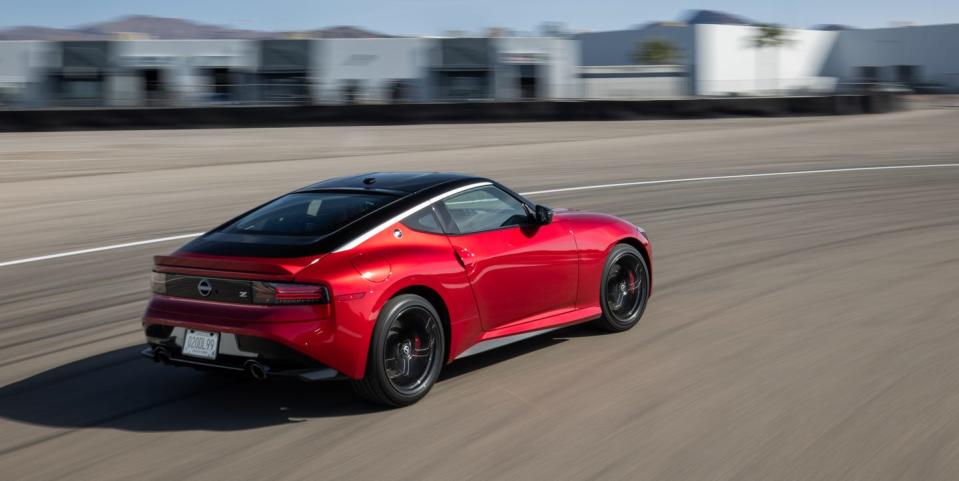
2023 Nissan Z arrives in showrooms this summer with 400 hp and an all-new look.
There are shared and carryover components on the car but Nissan says it’s 80% new, and if that’s what it takes to keep sports cars available on the market in these crossover times, that’s fine.
The new car competes against the Gazoo Racing Toyota Supra, for one.
The new Nissan Z is finally here! Check it out. It’s a fitting evolution of the iconic coupe that changed the sports car world back in 1970, except that this one has 400 hp from a refined and powerful twin-turbo V6, mated to your choice of a nine-speed automatic or six-speed manual with styling cues inside and out that you can trace in your mind all the way back to that first Z you coveted in high school.
Whatever you think, we should all be glad that we still even get sports cars at all in this crazy, mixed-up world of ours where everyone wants practical crossover utility vehicles. Nissan sells a lot of those, for sure, but it also sells the GT-R and this magnificent new Z. And that’s not an easy thing to do.
It’s not easy, for instance, convincing the bean counters to greenlight a sports car anymore. If you look at almost all sports cars that are not supercars, as we did on a sales chart from Wards Intelligence, the segment is down almost across the board. Chevolet Corvette, Subaru BRZ, and Toyota 86 sales are up, because those are new and exciting. But the rest of the segment—from Camaro, Dodge Challenger, Ford Mustang, Mazda MX-5 Miata, and even the Hyundai Veloster—are down. The old Z sold just 163 units a year ago, likely because Z-car intenders were waiting for the new model. (Conversely, Nissan claimed “sports car” sales are up 25% since 2018, citing stats from a company called Urban Science.)
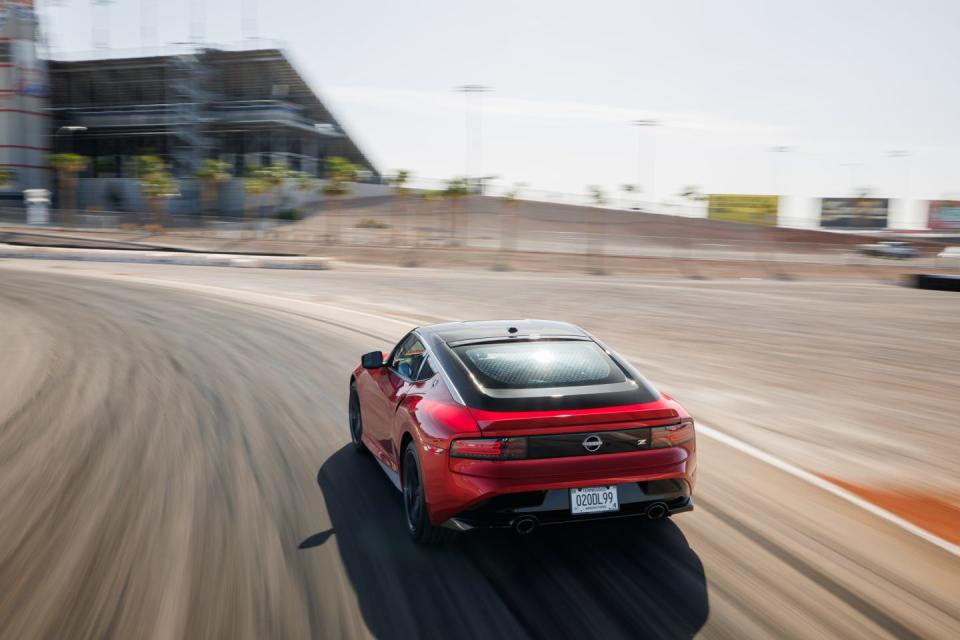
Part of this sales decline has to do with supply-chain issues, COVID, and the alignment of Pluto in opposition. But the bigger reason is just the nature of what are called the small- and medium-specialty and specialty-luxury car segments, as defined by Wards. That’s where all the fun cars lurk, the ones car magazines slobber over. In order to justify small-volume sellers like these, carmakers must amortize their development costs over 10 years or so, compared to five years for a CUV. That, or they have to share development with other makes, as Toyota and Subaru did with the 86 and BRZ, or Aston Martin does with AMG several classes up. Plus, cars in this segment have relatively short production runs. When they’re new and exciting, everyone wants one. But soon enough, the next big thing comes out and buyers forget last year’s hot car. It has happened since the Model T speedster and will keep happening when the latest anti-gravity speeder pods come out.
So, as we say, be thankful we still have sports cars!
And quit whining about some parts sharing or all the other methods of cost-savings carmakers use to keep the cool cars coming. For instance, some will complain that the new Z isn’t really new but is more like a revised version of the old Z, that the chassis is carryover and the drivetrain is borrowed. Those naysayers are right, to a certain extent. Many parts are carryover, but most are new or revised. And the chassis is mostly new or revised, and is stiffer and stronger than what it replaces, up 11% in torsional stiffness and 24% in body rigidity. Nissan says 80% of the car is new.
Also: That new exterior is less adorned, less complex, but still keeps to the styling edict assigned over 50 years ago when the first Z, the legendary 240, changed what the world thought a sports car could be.
Inside there are cues striking back to earlier Zs, particularly those three gauges popping up out of the center of the dash like whack-a-moles to give you turbocharger boost, turbocharger tach, and volts, left to right in that order.
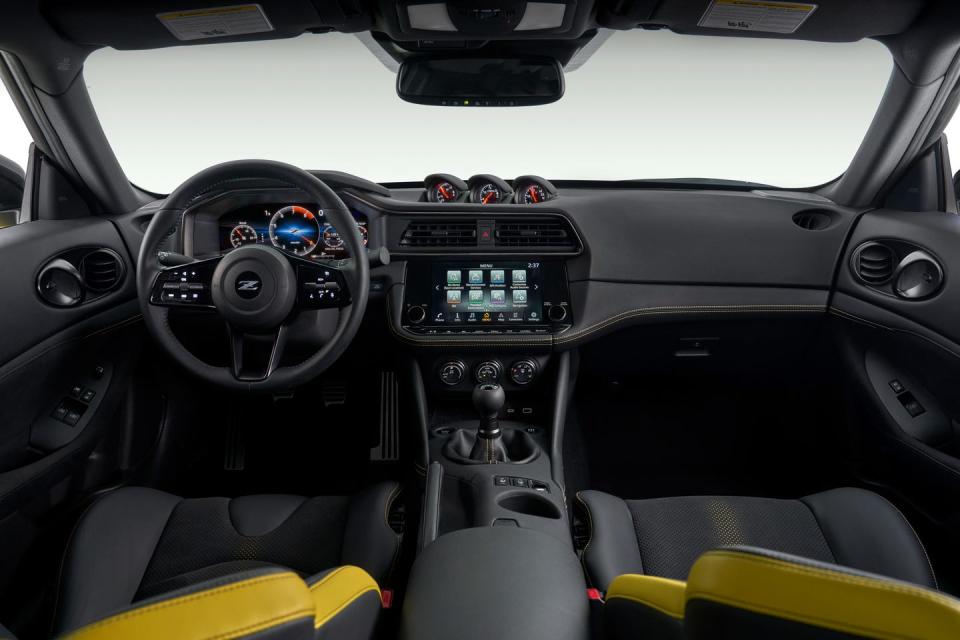
And under the hood is a more responsive, far more sporty version of the 3.0-liter twin-turbo V6 we first loved in the Infiniti Q50 Red Sport. This version of the VR30DDTT twin-turbo 3.0-liter V6 makes 400 hp, while the VQ37VHR V6 in the previous Z, the 370Z, was naturally aspirated and made “only” 332 hp.
By adding two turbos and tuning them for quick response with lightweight vanes and speed sensors to maximize boost at all engine speeds, Nissan engineers were able to not only maintain that 400-hp peak, but broaden and flatten the power curve significantly to give an even distribution of ponies across the tach. A recirculating valve keeps boosted air inside the system instead of blowing it off, thus helping create that more immediate, sharper response. Other features like variable valve timing on the intake side, a water-cooled charge cooler and an integrated exhaust manifold are all aimed at creating what Nissan, again, calls a sharper response from the engine compared not only to the old 3.7-liter but also to the powerplant in the Infiniti Q50 Red Sport.
That new engine is mated to your choice of a six-speed manual or nine-speed automatic. Yes, it’s a version of the same nine-speed that sits in the Frontier and the Titan, but at least you know it can handle the Z’s 350 lb-ft of torque, available from 1600 to 5200 rpm. Plus, the auto trans’ case is now made of lightweight magnesium, which Nissan says saves 44 pounds. Two more gears were added to the auto compared to the 370 Z’s seven-speed slushbox, and through the black magic that goes on in an A/T, that allows for unique ratios in this application. The six-speed manual, meanwhile, gets rev-matching in the Performance and Proto Spec trims as well as a new linkage and redesigned synchros in first and second. There is launch control in both, and you can get a mechanical limited-slip diff and “Nissan Performance Brakes” on Performance and Proto models, too.
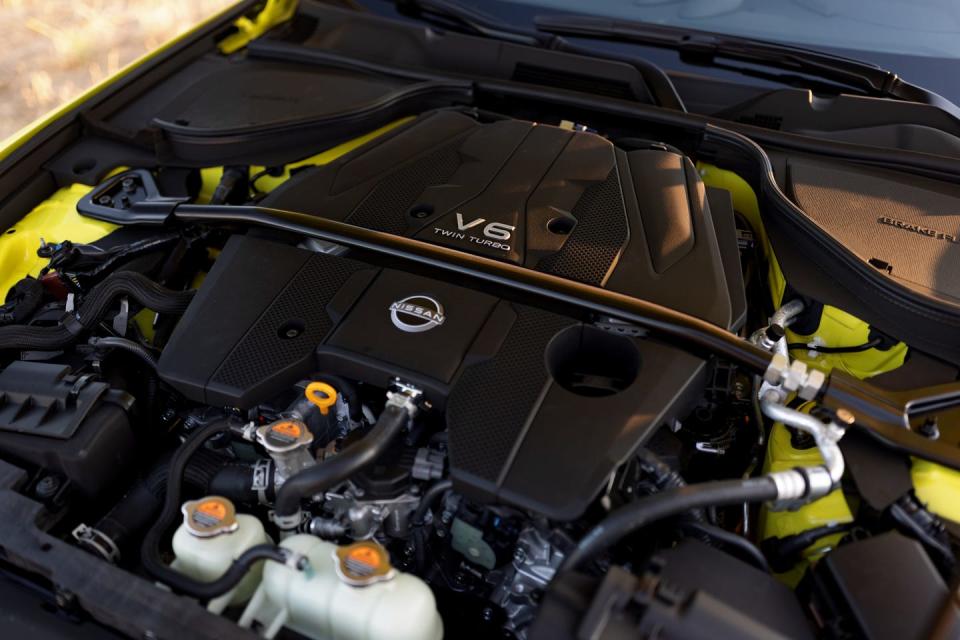
So how does it compare with the great Zs of yore? Or more importantly, how does it compare with the competition? We recently got to spend a day driving new Zs on a road course, at a drag strip, and out in the wilds on twisty two-lane hill-country roads outside Las Vegas and came away generally liking it.
The track was the road course outside of LVMS’s big stadium oval. It’s a nice mix of fast, easy turns and a couple long sweepers that require a little courage and a stable car. The new Z has lots of power and torque to push out of corners and down the straights. Indeed, the torque and power curves felt just as broad and flat as Nissan said they would. But the curb weight of between 3486 and 3602 pounds felt a little on the hefty side, pulling the Z over as it rounded corners, if not holding it back on the straights. The suspension felt softer than you would want on a track-day car, but that’s what SEMA and the aftermarket are for.
As is, the BMW straight-six-powered Gazoo Racing Supra that I just happened to have driven from Los Angeles to Las Vegas for the Z program felt much more sporty, albeit with about 10 grand on top of the Z’s sticker, depending on how you load them up. I imagined the Supra might have been more darty in corners, but was far more confident on the twisty mountain roads I had been driving (I never drove the Supra on the track).
The new Z’s manual transmission required pauses between shifts; you can’t be too quick. Nissan says a “Power On Shift” feature allows you to shift the manual without lifting off the gas, but, in a major failing of testing on my part, I didn’t try that. (Old habits die hard—it's counter-intuitive to keep the gas pedal mashed while changing gears, right?) Forgive me, or lambaste me in the comments. Let’s just assume it works as advertised. The new nine-speed was quick enough, but why does everything need nine speeds nowadays? With all this torque it could easily make do with, what, a four-speed? I tried the automatic in both manual and auto modes and preferred manual at the track.
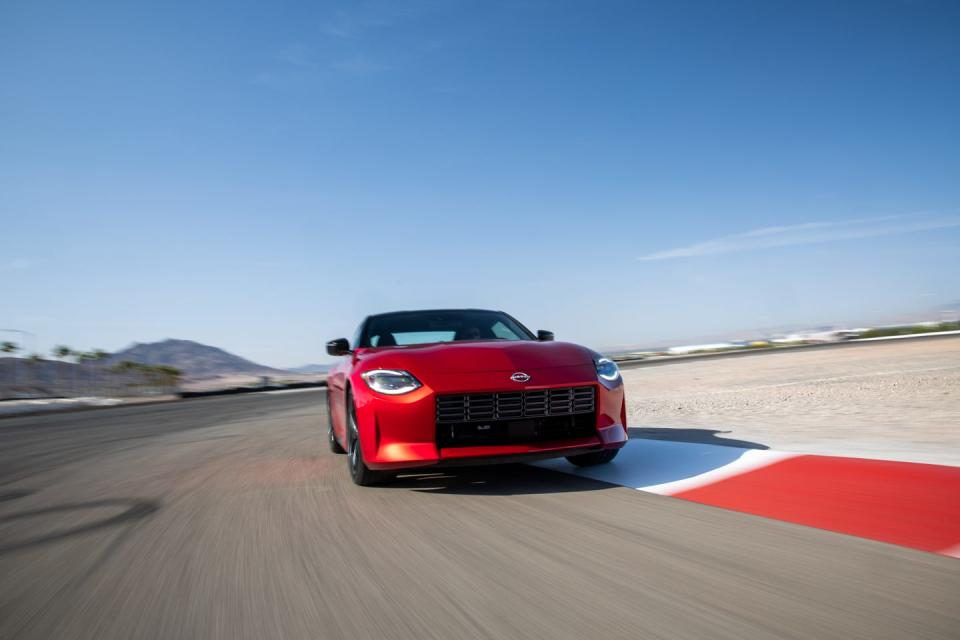
On the drag strip, or the shortened maybe 1/8th-mile setup they’d improvised from the LVMS pit straight, all was forgiven. Click launch mode and feel all that heft disappear down the straight line. Unclick launch mode and you get rubber in all three of the gears available before the short strip ran out of room. This could have been the car the Beach Boys were singing about (though theirs got rubber in all four gears). I drove it back-to-back with the 370Z and you really notice and appreciate all that new power.
On the street and in the hills the Z felt more together than it did on track. There was no pitch or yaw and out there, with often uneven pavement, the softer setup was more appropriate.

So is it worth 40 grand?
Yes, the Z Coupe Sport stickers at just $41,015. That’s with your choice of six-speed manual or nine-speed transmission. You can also get the Z Coupe Performance, also with same-cost choice of manual or automatic for $52,015. A limited-edition—only 240 of which will ever be made—Z Coupe Proto Spec will cost you $54,015. But all the performance you really want you are likely to find in that entry-level Z Coupe Sport spec.
If you’re serious about sporty driving and maybe even track days, you should at least test drive the Gazoo Racing Supra, which hovers not far from the Z in price and above it in track performance. These cars are a step above the BRZ/86 twins and way above the Miata. Muscle cars like the Camaro, Challenger, and Mustang, which can be outfitted almost any way you can imagine, are probably not going to be cross-shopped too much, but they’re out there if you have room on your shopping list.
Yet for many who remember the revolutionary 240Z of 52 years ago and all six generations of Zs since, there is no substitute for the last letter of the alphabet.
Has a Z car ever graced your garage? Share your memories—and hopes for the new car—in the comments below.

 Yahoo Autos
Yahoo Autos 